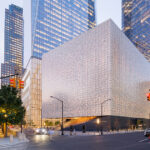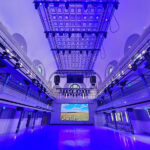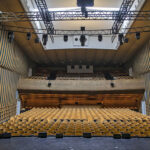Elation, Daktronics and Flying by Foy Help Engineer a New Cruise Ship Experience
Royal Caribbean Cruises Ltd. (RCCL) bills their newest cruise ship as the most technologically advanced to date, with broadband Internet access, digital wristbands to track passengers’ movements and purchases and personalized mobile apps. In short, a “smart ship,” named “Quantum of the Seas.”
The entertainment options offered had to reflect this innovative approach.
 Designer Christopher Vlassopulos has been with the cruise line for 15 years as the superintendent of stage, lighting, video and architectural lighting. “When I was hired,” he says, “I was promised a free hand in some great projects; it’s truly been all of that and more.” As the overall project manager on Quantum’s entertainment spaces, Vlassopulos’ goal to meet “smart ship” status meant moving to energy-saving LED show light technology, eliminating dimmers and conventional lights.
Designer Christopher Vlassopulos has been with the cruise line for 15 years as the superintendent of stage, lighting, video and architectural lighting. “When I was hired,” he says, “I was promised a free hand in some great projects; it’s truly been all of that and more.” As the overall project manager on Quantum’s entertainment spaces, Vlassopulos’ goal to meet “smart ship” status meant moving to energy-saving LED show light technology, eliminating dimmers and conventional lights.
“Elation joined with us to provide design and engineering assistance that we need as an end user,’’ he says. “As we have, over the years, they understand the ship building process. It can be difficult and complicated. Elation was all in right from the beginning, involved in a lot of discussions and changes over a two-year period before we purchased a single fixture. It does help that they have a great showroom only a few miles from our office.”
 Vlassopulos adds that Elation has “been true to their promise, and now the Ship is sailing, we have experienced wonderful support. They did much, much, more than sell their product; they made sure all the equipment was cruise ship ready.”
Vlassopulos adds that Elation has “been true to their promise, and now the Ship is sailing, we have experienced wonderful support. They did much, much, more than sell their product; they made sure all the equipment was cruise ship ready.”
“Our first new build work with RCCL was in 2008,” recalls Elation’s Eric Loader. Elation worked through Funa (funa.com), the design firm that supplied entertainment lighting for Oasis of the Seas. These efforts led RCCL to award the contract to Elation’s German dealer, Amptown, which became the primary contractor on installation. Sales teams in Miami and Europe came on board to work closely with Amptown to help ensure that the products would fit the RCCL design team’s needs.
Shortly after the beginning of this three-year build, RCCL announced the addition of two more new “smart ships,” with a third following in their wake.
 “We are looking at a six-to-seven-year build, not to mention the years of support required afterwards,” says Loader. “Not many companies can sustain that much time dedicated to one project.”
“We are looking at a six-to-seven-year build, not to mention the years of support required afterwards,” says Loader. “Not many companies can sustain that much time dedicated to one project.”
RCCL knew they needed a well-established company with global support capabilities. They wanted to know what was in the pipeline to plan their budget as well as a certain level of assurance that the products specified would still be around three or five years later. In that length of time, LED product often would be in its second or third generation, so we had to plan for that.”
The Goal: A Unique Show
 The “free hand” promised Vlassopulos has shown him different avenues to realize his designs. After seeing Bon Jovi’s 2010 The Circle tour, Vlassopulos contacted Zurich, Switzerland ABB, a multinational corporation operating mainly in robotics, power, and automation technology. ABB had provided the robotic video screens on that tour.
The “free hand” promised Vlassopulos has shown him different avenues to realize his designs. After seeing Bon Jovi’s 2010 The Circle tour, Vlassopulos contacted Zurich, Switzerland ABB, a multinational corporation operating mainly in robotics, power, and automation technology. ABB had provided the robotic video screens on that tour.
Nick J. Hunt is a manager of product technology and support in the robotics business unit of ABB, with a home office in Auburn Hills, MI. He served as the technical manager on the Quantum of the Seas robot project.
“It was about five years ago when I met Andy Robot, and he first started talking about this project,” says Hunt. “He mentioned the Bon Jovi tour that had a couple of our robots on it and it seemed like everyone later on always referred to that as the seed for this idea. Our robots build BMWs, so this was all new to me.

“There were a lot of discussions before ABB received the contract,” Hunt continues. “I had my first meeting with the RCCL team in Miami. With my engineering background, I had drawn up about three pages of what could go wrong. I told them I thought this project would be quite difficult to achieve. They kind of chuckled and said to me, ‘Nick, we aren’t doing this because it is easy. We are doing it because no one else ever has.’”
The risks and challenges included a few language hurdles — both human and robotic. “We had some entertaining meetings at first,” says Hunt. “Both parties would be talking about the same thing, with RCCL’s creative people speaking in stage lingo, and my team speaking in terms of science and physics. Eventually we ironed it out.
 “For the robots,” Hunt continues, “I sent an application and a software engineer out to see [Andy] Flessas in Vegas. He is an animator, and our programs were not fluid enough to execute his operations. In our field, we want to get from point A to B as quickly and safely as possible. It does not matter how it looks, it just has to be efficient. That is exactly opposite the logic Andy writes. His is more like choreography. What took the Bon Jovi project three months, these three guys did in two weeks.”
“For the robots,” Hunt continues, “I sent an application and a software engineer out to see [Andy] Flessas in Vegas. He is an animator, and our programs were not fluid enough to execute his operations. In our field, we want to get from point A to B as quickly and safely as possible. It does not matter how it looks, it just has to be efficient. That is exactly opposite the logic Andy writes. His is more like choreography. What took the Bon Jovi project three months, these three guys did in two weeks.”
The creative concept that brings the robots to life on stage is RoboScreen, a patented technology developed by inventor Flessas, a.k.a. “Andy Robot,” the founder and president of Las Vegas-based Robotic Arts. Flessas’ experience with robots began in mid-1990. His company reached elite status in 2006 when he completed a robotic programming, design and operation certification program at the ABB training facility. Along the way he developed the idea of mounting a graphic screen on a robotic arm to bring controlled movement to the visual media and create a unique viewer experience.
 Flessas’ proprietary Robot Animator 3D computer animation software brings the robots to life on stage, and the final result, first featured within the Two70 venue aboard the Quantum of the Seas, is “really quite a show to see,” Hunt notes. The software provides a separate interface to animate the movement of the ABB robots as if they were on-screen characters. “We didn’t just create an industry first,” points out Vlassopulos, “it’s a world first,” seen only at the Quantum of the Seas, which took its maiden voyage in Nov. 2014, and sister ship Anthem of the Seas, which first set sail April 22, 2015.
Flessas’ proprietary Robot Animator 3D computer animation software brings the robots to life on stage, and the final result, first featured within the Two70 venue aboard the Quantum of the Seas, is “really quite a show to see,” Hunt notes. The software provides a separate interface to animate the movement of the ABB robots as if they were on-screen characters. “We didn’t just create an industry first,” points out Vlassopulos, “it’s a world first,” seen only at the Quantum of the Seas, which took its maiden voyage in Nov. 2014, and sister ship Anthem of the Seas, which first set sail April 22, 2015.
Meanwhile, Back on the Plains…
Although its Brookings, SD, home base has never been a cruise ship’s port of call, Daktronics played a key role, providing the six custom-built 4mm SMD LED screens on the robotic arms, each measuring four by seven feet. This company started in a garage in 1968 by two electrical engineer professors at South Dakota State University. Their first products were scoreboards for high school and college wrestling tournaments. The company, now has offices worldwide.
 Recently, for the NFL Jaguars, Daktronics installed the largest HD LED video displays in the world. (Each of the 362-by-60-foot screens installed beyond the end zones at EverBank Field in Jacksonville, FL could stand, by itself, as the world’s largest.)
Recently, for the NFL Jaguars, Daktronics installed the largest HD LED video displays in the world. (Each of the 362-by-60-foot screens installed beyond the end zones at EverBank Field in Jacksonville, FL could stand, by itself, as the world’s largest.)
Matt Anderson is on the live event marketing staff of Daktronics. He deals with sports, music and cruise line installations. Following is his recollection of the Quantum project. “Andy Robot is the guy who brought this project together for RCCL. He corralled us, ABB in Detroit, and finally, Moment Factory, the content producers, to develop a vision he had. It was new ground, you know, so a lot of engineering and testing went into this before the install. The three parties made their rounds to each other’s factories to collaborate on signal flow, mainly.”
Daktronics’ LED systems include a propriety signal processor to translate video control feeds. Out of the meetings, the company developed additional and unique applications to get the various controllers to talk to each other. Peter Dunkle, a Daktronics project manager, and a couple of the company’s top engineers went to their offices in Germany to train staff on the new technology and the install on the ship.
“After that,” says Anderson, “they did the initial install where the gear sat for about a year!” The Two70 room was located on the end of the ship constructed first, so the gear, fiber optic signal, and power had to be in place before building continued. Dunkle returned later to supervise the install completion and train ship staff.
 Concert Land of the Future
Concert Land of the Future
LD Susan Rose was probably the one person on the project who walked into a completed venue her first day aboard the ship. Over the course of her successful career, she has designed and programmed many productions for ships. The Imagination House (TIH), which handles projects for clients including Disney, TV show producers, theme parks and cruise ships, hired her to design the Two70 venue’s automated show.
“I boarded in South Hampton, U.K., for Quantum’s maiden voyage,” Rose says, “and spent about 10 days on the inaugural run programming. My directive was to create a “virtual concert” by designing this rock ‘n’ roll light show that interwove with the RoboScreens and imagery the video company, Moment Factory, created.”
 For the show, video projection screens roll down, covering the ocean windows. Sixteen projectors then light up these screen surfaces, providing a 270-degree upstage background called the “Vistarama.” The six Daktronics LED screens on robotic arms then fly in from the grid on a gantry. The “band members,” along with images created by Moment Factory, appear on both the Vistarama screens and LED RoboScreens. Theodore Tsevas, the master show control programmer, manages the coolux media servers, audio and telemetry with the Robots.
For the show, video projection screens roll down, covering the ocean windows. Sixteen projectors then light up these screen surfaces, providing a 270-degree upstage background called the “Vistarama.” The six Daktronics LED screens on robotic arms then fly in from the grid on a gantry. The “band members,” along with images created by Moment Factory, appear on both the Vistarama screens and LED RoboScreens. Theodore Tsevas, the master show control programmer, manages the coolux media servers, audio and telemetry with the Robots.
“It was actually the perfect assortment of fixtures for this type show,” continues Rose. “I needed to walk that line between video and light to make sure nothing washed out. I had to dial back intensity to help keep that balance. I was impressed with how far Elation has brought the LED product, especially the hard edge, like the Satura Spot and the Platinum Pro LED. Of course, I love the ZFX, with all its internal macros. I have used those on other shows of mine.”
 A Punishing Environment
A Punishing Environment
“The driving force behind the use of LED products was energy savings,” says Vlassopulos. “They require less power, are an extremely long lasting product with up to 50,000 hours of life, have no mercury in them and produce very little heat, so less air conditioning is required.”
“For instance,” he continues, “the Music Hall is a multi function space with live acts, discos, lectures, and presentations. The Design Brick 70 II, Platinum Spot LED Pro II and Platinum Wash ZFX Pro handle the various setups in that room nicely. We also have successfully used Elation Elars since they became available and continue to do so as they are robust and bright. For Quantum, they are put to use extensively on the Pool Deck, Sports Deck, and crew Sun Deck.” Equally important to ship usage, LED are resistant to shock and vibration. As Vlassopulos notes, “ships can be a very hostile environment for lighting fixtures.”
Rose agrees. “Ships are hard on fixtures. Every time I’ve gone on one to program, the techs are always repairing fixtures. Each day the ship pulls into port, the valve thrusters kick in for navigation in the harbor. While this is going on, fixtures shake violently for five minutes or more. It is almost like an earthquake! Dichroics and sensor motors rattle around. There are heat issues and power issues when they swap over from ship to shore power. LED’s do not have these types of issues due to the way they are built,” she says.
Vlassopulos notes that the Elation/ADJ/Acclaim LED product line provided several solutions for other design challenges he encountered. “In the Royal Esplanade and SeaPlex, the lamp change is difficult so we used the Platinum Wash LED Zoom, paired nicely with Platinum Spot LED PRO II.” Acclaim Rebel Drums, meanwhile, “worked perfectly for Boleros due to limited cove space. Also in the Crew Bar Disco, American DJ Inno Scans provided some ‘flash and trash.’” Vlassopulos also credited Pulsar’s ChromaAR111 fixtures for their combination of “punch” and “low profile” for the Crew Bar Disco and English Pub areas.
Two70, like the Music Hall, needed a flexible rig to provide for a wide variety of possibilities. Currently, two very different shows are staged in the space — the “Virtual Concert” and a full-on theatrical production, Starwater. Says Weir, “Not only did Moment Factory create all the video content for both shows, they wrote, staged, and produced Starwater. Andy introduced the Factory staff early on to Daktronics and ABB to get them familiar with the unique element of ‘dancing’ robotic screens. Andy’s vision was achieved, and Moment Factory certainly exceeded my expectations.”
To the Moon, Alice!
No fantasy is complete without flying actors. The legendary company Flying by Foy came on board to accomplish the aerial effects. Foy has quite a long history with cruise ship productions.
Dustin Donohoe, one of Flying by Foy’s flying directors, did the last month of rehearsals at Nova Southeastern University in Fort Lauderdale, FL with the Starwater cast before moving aboard. Foy has a longstanding relationship with Royal Caribbean, supplying all the motors and rigging on at least 10 previous productions.
“On the ship our time was very compressed. Everyone needed the stage at all times, it seemed,” he said. Installing the automated fly system early in construction enabled the other participants in the space to see where Foy’s equipment landed. Called an eight-axis system, because there were eight motors, the actors negotiated their way through the catwalk in the air to get to wherever their next entrance took place. This system did not have any travelling tracks. Beneath the stage, a series of hatches provided access mimicking the catwalks above. At each entrance and exit, two Foy trained riggers managed the harness and fly cable for the actor. Two sets of eyes are always on the actor for safety sake. Another safety feature, and a first in the industry, is the weight sensors atop each lift that opens in the stage floor. These monitors prevent a hatch from opening if the sensor detects weight.
A third Foy trained rigger, usually the crew chief, operates the Pegasus system, the proprietary automated control desk developed by Foy to handle flying effects with the actors.

Summing Up
Passengers on both the Quantum of the Seas and Anthem of the Seas will be enjoying a unique entertainment experience undergirded by the high degree of professionalism that can only be achieved through production partners committed to a long-term focus, Vlassopulos says. “The nice thing is, we really know all the people at Elation and they know us. We make sure we partner with the best folks in the world to realize our visions.”


